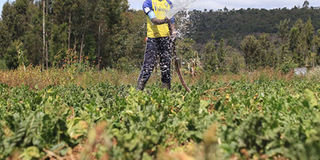UN speaks positively about Kenya’s economic growth

A farmer irrigates his crops in Nyeri. Agriculture remains one of the key sectors that can positively or negatively affect a country's economy. PHOTO | FILE | NATION MEDIA GROUP
What you need to know:
- The UN says East Africa’s economic outlook remains heavily dependent on factors beyond its control such as commodity prices.
- In Kenya, according to a UN table, the bottom 20 percent of earners received about eight percent of total income in 2015.
Economic growth is expected to remain strong in Kenya and the rest of East Africa this year and the next, the United Nations said.
However, it also warned of persistent income inequality and “considerable downside risks” in the region.
East Africa ranks as the fastest growing part of Sub-Saharan Africa, according to the UN’s World Economic Situation and Prospects 2019.
The report said overall economic expansion in EA measured 6.2 percent in 2018 and is forecast to accelerate to 6.4 percent (2019) and 6.5 percent in 2020.
Kenya’s economy grew by nearly six percent last year and will sustain that level in 2019 and 2020, the report said.
BURUNDI
Uganda’s gross domestic product (GDP) growth rate closely tracks that of Kenya, while Tanzania’s is set to rise by nearly seven percent next year, the UN noted.
Politically unstable Burundi qualifies as the economic outlier among the 13 nations which, in the UN’s configuration, make up East Africa.
Burundi’s economy barely grew in 2018 and will expand by less than one percent next year, the UN calculates.
“The region benefits from improvements in stability, new investment opportunities and incentives for development of new industries,” the 218-page global survey states in its EA section.
“The increased government expenditure on infrastructure and rapid expansion of the construction, real estate and retail sectors in Ethiopia and Kenya will continue to boost regional growth,” the study adds.
OIL PRICES
The EA’s economic outlook remains heavily dependent on factors beyond its control such as commodity prices, the UN notes.
“Low coffee prices will weigh on the Ethiopian economy, while moderate tea prices will be beneficial for the Kenyan economy,” the report says.
Diminishing political uncertainties in both those countries are likely to boost domestic investment and foreign capital inflows, the UN predicts.
Armed conflicts or rising political tensions weigh upon the economies of Burundi, Democratic Republic of Congo, Somalia and South Sudan.
All countries in EA, except for oil-producing South Sudan, are expected to benefit from low global oil prices.
Despite the brisk growth rate the region has enjoyed in recent years, “the situation remains almost unchanged regarding income distribution”, the UN finds.
Estimates show that in 2000 the bottom 20 percent of East African earners received 6.5 percent of the region’s total income, while the top 20 percent collected 48 percent.
INEQUALITY
Income inequality remained just as pronounced in 2015 — the latest year for which these statistics are available.
In Kenya, according to a UN table, the bottom 20 percent of earners received about eight percent of total income in 2015.
The top 20 percent got close to 48 percent. That imbalance for Kenya lessened slightly during the 2000-2015 period, the UN figures suggest.
“A large share of employment in agriculture remains one of the reasons for a low share of income at the bottom of the income distribution” in East Africa, the report observes.





